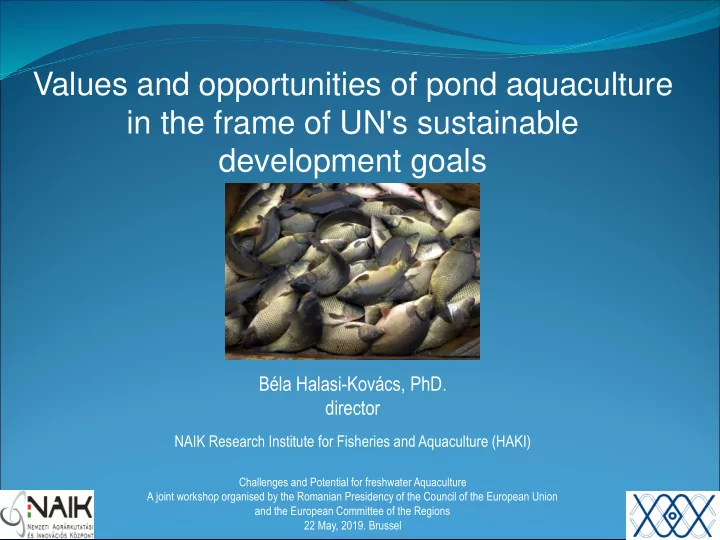

Values and opportunities of pond aquaculture in the frame of UN's sustainable development goals Béla Halasi-Kovács, PhD. director NAIK Research Institute for Fisheries and Aquaculture (HAKI) Challenges and Potential for freshwater Aquaculture A joint workshop organised by the Romanian Presidency of the Council of the European Union and the European Committee of the Regions 22 May, 2019. Brussel
Sustainable development goals of UN’s
Pond aquaculture is the cultural heritage of Europe… • Written and painted relics from the medieval Europe „ Thursday ” painted by Walter Dendy Sadler Military map from the 18th century with fish ponds in Transylvania (1854 – 1923) Janus Dubravius (1547): De piscinis et piscium, qui in illis aluntur, naturis, libri quinque, út doctissimi, ita ad rem „ The Four Elements :Water” painted by Joachim „ Still life with fish and cat ” painted by Clara Peeters familiarem, augendam utilissimi Beuckelaer (1535-1575) (1594 – after 1657)
…and in Asia too. Fan Li in b.c 550 described the basis of pond aquaculture in China • Mulberry-dyke and fishpond system about from 1350 •
Contribution of freshwater aquaculture to the total production Global aquaculture production by origin Brackish water 11% Marine 29% International landscape of fisheries and aquaculture Fisheries Aquaculture Position (Mt) (Mt) #1 China 17.6 China 47.6 Freshwater 60% #2 Indonesia 6.5 India 5.2 #3 USA 5.0 Indonesia 4.3 Source: FAO Fishstat 2018 #4 India 4.8 Vietnam 3.4 #5 Peru 4.8 Bangladesh 2.1 #6 Russia 4.6 Norway 1.4 #7 Japan 3.5 Egypt 1.2 #8 Chile 3.0 Myanmar 1.0 #9 Vietnam 2.8 Chile 1.0 #10 Norway 2.3 Thailand 0.9 Source: EUMOFA 2018
Contribution of freshwater finfish aquaculture to the total production Source: FAO 2018
Relevance of carps production in the world aquaculture Aquaculture growth: recent trends and forecasted values 40.000.000 35.000.000 30.000.000 25.000.000 Tonnes 20.000.000 15.000.000 10.000.000 5.000.000 0 1995 1999 2003 2007 2011 2015 2019 2023 2027 Carps Salmonids Tilapias Other Freshwater Fish Other Marine Fish Source: FAO Fishstat 2018 Source: FAO Fishstat 2018, OECD/FAO, 2018
Pond fish farms contributes to achieve the EU environmental policies WATER FRAMEWORK DIRECTIVE
How can we boost the pond aquaculture in the EU Industry Research • Innovative • Focused Governance • Enabling
Tools for boost the pond aquaculture in the EU Innovations Support the additional costs Knowledge and technology of natural value transfer maintenance Sustainable intensification
Sustainable intensification of pond aquaculture Combining intensive-extensive systems • – Pond in pond system – Cage in pond system – RAS-pond system
Sustainable intensification of pond aquaculture Multi-functional pond fish farming • Higher and diversified farm income Additional employment opportunities
Innovation in freshwater aquaculture connected to pond farming New species in intensive systems • ˗ Pikeperch, ˗ European catfish Sustanaible feed ingredients and additives • ˗ Insect protein, ˗ Corn DDGS, ˗ Microalgae • Focusing on additional research ˗ Social acceptance ˗ Processing and marketing (product diversification, by-products utilization) ˗ Standardization, labeling
Support the maintenance of environmental values: „ blue pond ” subsidy • Pond aquaculture technology can be summarized as a complex value, important for nature conservation, water management and socio-economic aspects as well. Providing EMFF subsidy for this technology highly recommended for the sustainability of • wetlands and their associated values resulting from the fish pond management. The subsidy can be interpreted as supporting wetlands, rewarding „ blue pond” technologies • and best management practices. • Suggested support would be 300 EUR/ha/year for 5 years.
Knowledge and technology transfer: EATIP a European initiation AIM: identifying knowledge-based activities to improve the competitiveness of European aquaculture Being a trusted Science , Technology and Innovation link between the European • Commission and the aquaculture sector An industry driven, multi-stakeholder forum building knowledge capacity and promoting • innovation and evidence-based decision making
The Mirror platforms Freshwater related R&I recommendations Management of effective environmental factors. • • Social and demographic structure of rural fishery communities. Environment services: quantification of habitat restoration, ecosystem • services and water supply. • Decentralized aquaculture as a component in circular economy approaches. Socio-economic consequences and mechanism of subsidies for • production. Providing start-ups a realistic chance to access the arena of blue • bioeconomy and innovation.
Example of knowledge transfer: EURASTIP projekt Aim: knowledge and tachnology transfer to Vietnam, develop a fish breeding center with regional importance • Scientific exchange: HAKI (Hungary) - RIA1 (Vietnam) • Industry exchange: Vitafort Agro Asia (Hungary) -Mavin Group (Vietnam)
Main conclusions • Pond aquaculture has decisive importance in global aquaculture that ensure potential for European ones too. Pond aquaculture maintaines complex environmental values, so it is an • excellent example for circular economy. Pond aquaculture should be supported for maintainance of these • environmental values . The harmony of the three main elements – industry, research, governance – • of freshwater aquaculture sector must be ensure in order to increase productivity Pond aquaculture requires sustainable intensification and innovation, but the • additional research activities has eminent role to fulfill the demands of sustainable development goals of UN. The European pond aquaculture has great potential also in knowledge and • technology transfer.
Thank you for your attention! halasi-kovacs.bela@haki.naik.hu
Recommend
More recommend